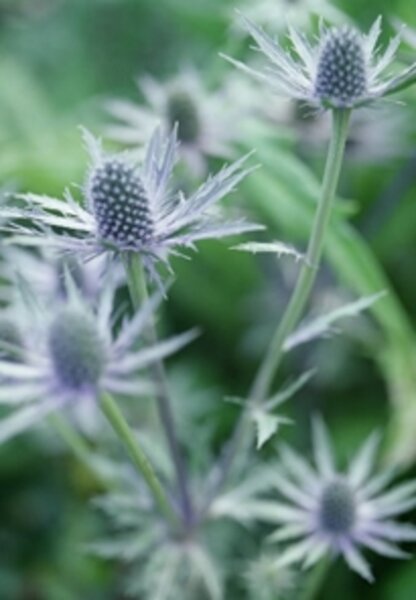Like a breath of sea air in the garden
Loading...
Sea hollies, Eryngiums, though highly popular in Britain, have never found their rightful niche in American gardens. They are sturdy perennials with handsome flowers that often are of striking blues and greens as well as silvers. The foliage, too, may be rich in color.
The scientific name Eryngium is from the Greek word for thistle – the flower heads do indeed resemble thistles. Sea holly flowers are favorites for cut flowers as well as for dried arrangements.
The sea hollies – most of which are originally from coastal areas, especially the Mediterranean region – thrive in sunny places and bloom for long periods during the summer months.
Because of their seaside origins, they are tolerant of salty soils. They also are tolerant of poor soil conditions and so will grow very successfully in ordinary garden soil. Full sun and well-drained soil are their major cultural requirements.
Although there is little resemblance, sea hollies are members of the parsley family and are therefore cousins of dill, fennel, and carrots. The roots of sea hollies are sweet and aromatic, a common characteristic of this plant family.
The highly dissected foliage is similar to parsley’s but much thicker and tougher, often with hard, sharp spines.
A wonderful story about the popularity of sea hollies in Europe is the tale of Miss Ellen Willmott (1858-1934), a wealthy Englishwoman known for her fabulous gardens and estates. As she grew older, she became increasingly peculiar.
Her extravagances eventually led to poverty as she squandered her inheritance, but in her prime she was welcome in all of the finest gardens in Britain and Europe.
Her favorite plant was the handsome, silvery bluish-green sea holly Eryngium giganteum ‘Bieberstein.’ As she toured gardens, she would secretly scatter the seedlike fruitlets of the plant. Thus her trail was often marked by the later appearances of this sea holly, and the variety soon came to be called Miss Willmott’s ghost.
To this day, this sea holly is commonly grown in Britain.
The Perennial Plant Association has recommended the Eryngiums as perennials that will bloom for at least six weeks. Although these plants are increasingly grown and sold in American garden centers, they still may not be easy to find. Persist and you will be rewarded.
Here are a few of the sea hollies considered most beautiful and valuable for American gardens:
• Alpine sea holly (Eryngium alpinum). This species grows up to 24 inches tall. The blue-tinted leaves are typically spiny and triangular to heart-shaped. The summer flowers are a rich blue and have ornamental bracts (they look like leaves that extend out under the flower) that open as pale blue and gradually darken.
There are several good cultivated varieties that derive from this one, including ‘Blue Star,’ with intensely blue flowers; ‘Amethyst,’ with small purple flowers and finely divided foliage; ‘Opal,’ with flowers of a soft lavender with a silver cast; and ‘Superbum,’ with blue-green leaves and large dark-blue flowers. This species is a favorite of many experts for its sheer impact. Hardy to Zone 5.
• Amethyst sea holly (Eryngium amethystinum). This one grows up to 28 inches high. The thick, green basal leaves that radiate from the base of the plant are egg-shaped, divided (like the leaflets on a fern frond), and spiny, while the upper foliage on the stalk consists of single, palmate leaves with three lobes.
Summer flowers range from steely blue to amethyst. The bright bracts extend beyond the flower heads and are spiny. This species is unusually cold hardy. Zone 2.
• Miss Willmott’s ghost (Eryngium giganteum). This is a short-lived, vigorous, rosette-forming species, usually biennial, that grows up to four feet tall. The basal leaves are heart-shaped, while the upper leaves are scalloped to toothed and spiny. The large, cylindrical “balls” develop in spring to early summer of the second year and are steel blue at maturity with prominent silver-gray bracts.
Bieberstein’ is the variety that Ellen Willmott liked to strew as she toured gardens. ‘Silver Ghost’ is a shorter form with gray-white flowers and narrower bracts. Zone 6.
• Rattlesnake master (Eryngium yuccifolium). An American native, rattlesnake master is increasingly popular with native plant enthusiasts. It has spiky, yuccalike blue-green foliage. Semievergreen, this perennial grows up to four feet in height.
The long, thin leaves have edges that may be smooth or spiny. The stiff stems rise from tuberous roots that smell like carrots when crushed. Greenish-white to pale-blue flowers appear during summer months and are densely packed into half-inch balls surrounded by conspicuous, pointed, gray-green bracts. Zone 4.
• ‘Jade Frost’ sea holly (Eryngium planum ‘Jade Frost’). Last year, the eminent plantsman and garden designer, Piet Oudolf of the Netherlands, introduced this cultivar – one of the first variegated sea hollies. It has two-foot flower stalks and a spread of about 14 inches.
The blue-green basal leaves are rounded and leathery with prominent white margins. When nights are cool, new leaves have pink edges. Violet-blue flowers appear on tall, branched stems in early to midsummer. Watch for this one at your local nursery!





